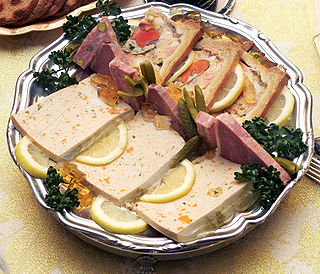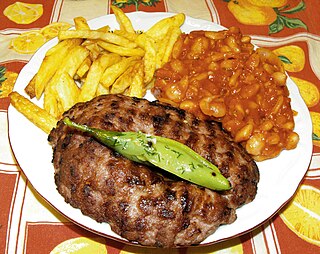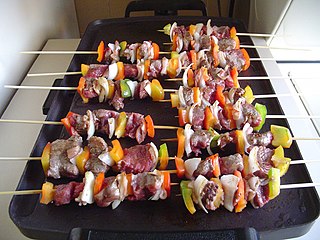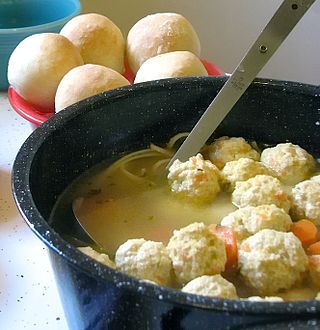
A sausage is a type of meat product usually made from ground meat—often pork, beef, or poultry—along with salt, spices and other flavourings. Other ingredients, such as grains or breadcrumbs, may be included as fillers or extenders.

Tripe is a type of edible lining from the stomachs of various farm animals. Most tripe is from cattle, pigs and sheep.

Mămăligă is a polenta made out of yellow maize flour, traditional in Romania, Moldova, Hungary, south-west regions of Ukraine and among Poles in Ukraine, the Black Sea regions of Georgia and Turkey, and Thessaly and Phthiotis, as well as in Bulgaria (kacamak) and in Greece. It is traditional also in Italy, Switzerland, Southern France, Slovenia, Croatia, Brazil, with the name polenta.

Offal, also called variety meats, pluck or organ meats, is the internal organs of a butchered animal. The word does not refer to a particular list of edible organs, and these lists of organs vary with culture and region, but usually exclude skeletal muscle. Offal may also refer to the by-products of milled grains, such as corn or wheat.

Kebab, kabob, kebap, or kabab (Kashmir) is roasted meat that originates from the Middle East. Many variants of the category are popular around the world, including the skewered shish kebab and the doner kebab with bread.

Moussaka is an eggplant (aubergine)- or potato-based dish, often including ground meat, which is common in the Balkans and the Middle East, with many local and regional variations.
Romanian cuisine is a diverse blend of different dishes from several traditions with which it has come into contact, but it also maintains its own character. It has been mainly influenced by Turkish but also a series of European cuisines in particular from the Balkan Peninsula and Hungarian cuisine as well as culinary elements stemming from the cuisines of Central Europe.

Ćevapi or ćevapčići is a grilled dish of minced meat found traditionally in the countries of southeast Europe. It is considered a national dish of Bosnia and Herzegovina and Serbia, with Bosnia and Herzegovina taking steps in branding and placing them on the list of intangible heritage, with a nomination for inclusion on the UNESCO List of Intangible Cultural Heritage. Ćevapi are also common in Albania, Bulgaria, Croatia, Kosovo, Montenegro, North Macedonia, and Slovenia.

Sarma, commonly marketed in the English-speaking world as stuffed grape leaves, stuffed vine leaves, or stuffed cabbage leaves, is a food in Southeastern European and Ottoman cuisine made of vegetable leaves rolled around a filling of grains, minced meat, or both. The vegetable leaves may be cabbage, patience dock, collard, grapevine, kale or chard leaves. Sarma is part of the broader category of stuffed dishes known as dolma.

Pljeskavica is a Serbian grilled dish consisting of a mixture of spiced minced pork, beef and lamb meat. It is one of the national dishes of Serbia and is very popular in the neighbouring Balkan and former Yugoslavian countries of Bosnia and Herzegovina, Croatia, Kosovo and Montenegro. It is a main course served with onions, kajmak, beans, sometimes ajvar (relish), and urnebes, either on plate with side dishes, or with lepinja. Recently, pljeskavica has gained popularity elsewhere in Europe and is served in a few speciality fast food restaurants in Germany, Sweden, and Austria. Varieties include the "Leskovac pljeskavica", very spicy with onions; "Šar pljeskavica", stuffed with kačkavalj cheese; "Hajduk pljeskavica", of beef mixed with smoked pork meat; and "Vranje pljeskavica".
Bosnian cuisine is the traditional cuisine of Bosnia and Herzegovina. It is influenced by Ottoman, Austro-Hungarian and Balkan cuisines.

Many regional cuisines feature a mixed grill, a dish consisting of an assortment of grilled meats.

Pleșcoi sausages are a Romanian sausage made from mutton spiced with chili peppers and garlic, traditionally made in and around the Pleșcoi village, in the Buzău County of Romania. If the mutton contains too much fat, it can be balanced with beef, but with no more than half of the mutton content.

Salată de boeuf is a traditional Romanian and Moldovan dish, generally served during all festive and special occasions. It is a combination of finely chopped beef and root vegetables, folded in mayonnaise and finished with murături, pickled vegetable garnishes. It can be made vegetarian, too.

Kebapche is a dish of grilled minced meat with spices. The meat is shaped into an elongated cylindrical form, similar to a hot dog. Typically, a mix of pork and beef is used, although some recipes involve only pork. The preferred spices are black pepper, cumin and salt. Kebapche is a grilled food. It is never fried or baked.

A meatball is ground meat (mince) rolled into a ball, sometimes along with other ingredients, such as bread crumbs, minced onion, eggs, butter, and seasoning. Meatballs are cooked by frying, baking, steaming, or braising in sauce. There are many types of meatballs using different types of meats and spices. The term is sometimes extended to meatless versions based on vegetables or fish; the latter are also commonly known as fish balls.
Babic sausages are a Romanian sausage made from beef and pork and strongly seasoned with spices. The original recipe contains pork and beef and has Slavic origins. It usually has a reddish color due to ingredients (spices) and is similar to ghiudem sausage.














